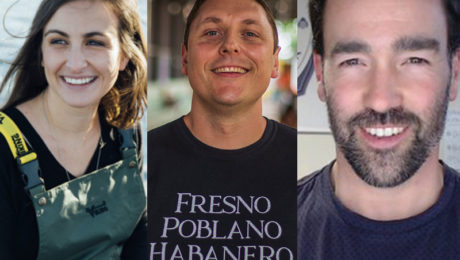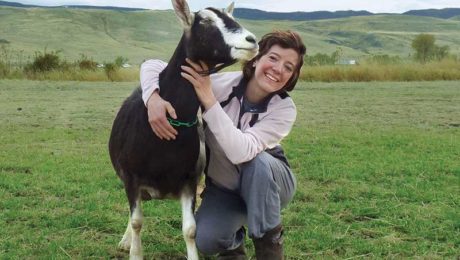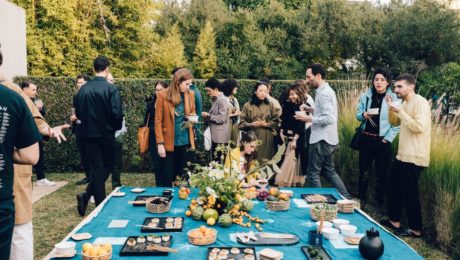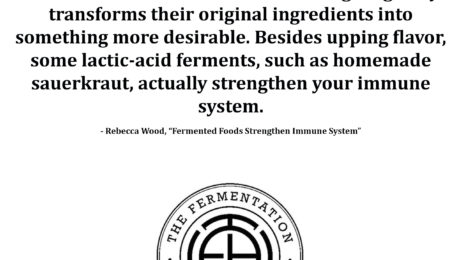Sales of Probiotic Products Rise
As the coronavirus outbreak continues to put health on the forefront of consumer’s minds, the sales of probiotic products are rising. GlobalData, an analytics company tracking grocery sales, notes that natto (fermented soybeans) were out of stock in Japan consistently since the outbreak. Sales of yogurt are also increasing.
“Consumers are more actively buying probiotic products. There will not be natto panic buying in Europe, but probiotic products claiming to improve the immune system are likely to grab consumers’ eye,” said Mitsue Konishi, senior innovation analyst at GlobalData.
Read more (Food & Drink Technology) (Photo by ABC News)
- Published in Business
Fermentation Grows Sustainable Alternative for Protein
The new wave of protein is not plant-based — it’s fermented.
“Fermentation is really cultivating microbes,” says Thomas Jonas, CEO and co-founder of Sustainable Bioproducts. “And it’s incredibly efficient. Microbes duplicate very fast. So when you think about the double time for a cow or a pig, you’re talking about years. When you talk about microbes, you’re talking about hours. … This is nature’s technology. Nature is really the No. 1 biotech engineer in the world.”
The current agriculture system is incredibly inefficient. Livestock continues to be the world’s largest user of land resources. Pasture land consumes 80% of total agricultural land. Fermented organisms are emerging as new sources of proteins and ingredients.
Leaders in the biotech industry shared how science is looking beyond plants to create food at a panel sponsored by The Good Food Institute.
Is Microbe Fermentation the New Era of Farming?
Sustainable Bioproducts creates a 50% protein based food ingredient from a microbe cultivated in the volcanic springs at Yellowstone National Park. Jonas explains that these fungal strains, called extremophiles, naturally produce a complete protein when grown in a controlled environment. Sustainable Bioproducts will soon move to a 36,000-square foot facility in Chicago’s former meatpacking district for production. The facility will take up just 0.7 acres. Compare the amount of food Sustainable Bioproducts produces to the equivalent of cow meat and 7,000 acres of grazing land would be needed for the cows.
“It’s the next generation of very efficient farming. I think what we want to get through farming are the nutrients that we need for our food. And microbes can do this tremendously efficiently,” Jonas said.
By fermenting proteins in bioreactors versus deriving the protein from plants or raising it and slaughtering it on a feedlot, food scientists can do a lot with the health profiles.
Michele Fite, chief commercial officer for Motif FoodWorks, said they work with microbes to adjust sensory attributes, like taste, smell, flavor and texture. “We can help so we don’t have to compromise taste or nutrition when consumers are looking to access plant based foods,” she said.
Adds Anja Schwenzfeier, business development manager for Novozymes: “You want to produce specific proteins that might already exist, but you want to do that more efficiently and more sustainably. You deal with molecules you’re already familiar with.”
“It’s not so much about creating a completely new protein. Right now we’re looking into how we can improve ingredients we already work with through fermentation.”
Fermentation as a Marketing Advantage
Panel moderator Jeff Bercovici, a writer for the Los Angeles Times, asked how biotech companies are meeting consumers in the development of fermented meat alternatives.
“(There is an) evolution of consumer attitude towards their food, which in some ways are really driving them very quickly to embrace meat alternatives, but in some ways there are some counter currents in terms of people wanting to eat whole foods, natural foods, foods with shorter ingredient lists,” Bercovici said.
The panel noted fermentation has long been a stable in the history of food, from beer to yogurt to cheese. As fermentation is making a comeback, it’s a “marketing advantage,” Bercovici notes, “now it’s a net positive, it generates consumer excitement.”
Fite at Motif FoodWorks said they’ve conducted research on meat alternative users. These consumers are currently buying meat alternatives because they believe it’s healthier than red meat and even chicken. “They want to be in this space,” she said. Consumers voice that meat alternatives are more sustainable, better for the environment, better for animal welfare and equally nutritious.
“They’re open to technology helping to solve that issue for them,” she said. “These consumers are more open to technical solutions than consumers that are a lot older have been in the past…there’s a gateway for these consumers to technical advancements, because they believe it aligns with their values.”
Adds Mark Matlock, senior vice president of food research at Archer Daniels Midland Company: “To me, it’s really refreshing to have some consumers who are embracing technology to this degree, to the extent that they may lead the mainstream their direction.”
Battling Land Use Challenges
As the global population grows, the great challenge to the environment over the next decade will be making more food with less space.
The average American consumes 215 pounds of meat a year. Raising that meat uses 32 million acres of land, and produces 82 million metric tons of greenhouse emissions.
“The real challenge for the planet is not going to be ‘Are we going to have enough oil or carbohydrates?’ it’s ‘Are we going to have enough protein?’” Matlock said. “We create protein the way a cow creates protein. … we have to think: where are our rare resources going to be put?”
A third of the corn crop grown in America feeds livestock.
- Published in Food & Flavor, Science
How Sourdough Bread is Rising in a Stagnant Bread Industry
Bread sales continue to flatline as consumers grow leary of gluten and chemical preservatives. But there’s one bright spot in the market: sourdough. Preservative-free, clean ingredient, fermented sourdough bread is growing increasingly popular.
Read more (CNBC)
- Published in Business
Bubbling Over: Is Fermentation More Than a Fad
We asked three fermentation experts if recent popularity of fermented foods is a fading trend or a new food movement. These industry professionals weigh in on their predictions for fermentation’s future. The fermenters include: Bri Warner (CEO of Atlantic Sea Farms, a commercially viable seaweed farm that makes kelp kraut and kimchi), Nicholas Gregory (owner of Pulp Hot Sauce, an Atlanta-based fermented condiment brand), Joshua Rood (co-founder and CEO Dr Hops Kombucha beer, a health-conscious alcohol).
Do you think the surge of fermented food and drinks is a trend will disappear or a new food movement here to stay?
Bri Warner, CEO Atlantic Sea Farms: “Now that we have a robust understanding of how good gut health effects overall health, I think fermentation is here to stay. I do think the category will continue to innovate to remain relevant, with a stronger focus on quality ingredients that are good for people, planet, and, in our case, oceans!”
Nicholas Gregory, owner Pulp Hot Sauce: “I think the current fermented food movement is here to stay. We are at an intersection of technology, science and health further than we have ever seen in human history. The internet, television, several seminal books and air travel have given us unprecedented exposure and access to information. This exposure and access to food and world cultures is more in depth than ever before. Including the food history and traditions of those cultures. Combine that awareness with a relatively intelligent and sophisticated medical system; an understanding of healthy lifestyles, a willingness to make healthy decisions, an understanding of the benefits of a healthy gut biome and how it all correlates to a longer, happier, healthier life. Along with a craving for umami and fermented funky flavors for a growing number of the population. I believe we are in the middle of a movement that shows no signs of slowing down or going away anytime soon. In fact, I see it only becoming more popular, more normal, more accepted, more diverse, more creative and more exciting in the decades to come.”
Joshua Rood, co-founder and CEO Dr Hops Kombucha beer: “As co-founder and CEO of Dr Hops Kombucha Beer, I appreciate that there is currently a powerful trend towards living, fermented foods. But answering the question of whether or not that will continue is repugnant. We here at Dr Hops are driving that trend! We are not playing the game of hoping that it will simply continue. We are committing ourselves, each day, to the life-enhancing awesomeness of fresh, authentic, fermented foods and beverages. Please join us in that! Join us in leading the health-conscious food and beverage revolution!”
- Published in Business
Though Dairy Industry Sales Continue to Decline, Specialty Cheese Market Grows
Cheese making is a craft steeped in tradition. But as industry-altering trends emerge — like innovative ingredients, plant-based dairy, sustainable operations — how can cheese creameries compete?
At the Winter Fancy Food Show, heads of two specialty cheese companies in Northern California shared their insight about innovations and trends in specialty cheese.
Consumers are shunning processed cheese for specialty, small-scale, fermented, farmstead brands. Research from Winsight Grocery Business shows that specialty cheese sales are growing. Though sales of dairy-based cheese dipped in 2019, specialty cheese sales are up 2%.
Using Innovative Ingredients
“In cheese, the great thing is that tradition is always up-to-date,” says Manon Servouse, brand manager for Marin French Cheese. Founded in 1865, Marin French Cheese still uses the traditional art of French cheese making, but “we add innovation with inspiration from our local area” in Marin County, California, where Marin’s operations are located.
Marin’s new ingredients include adding jalapeno, truffle and ash coating.
Laura Chenel cheese, meanwhile, is also experimenting with new flavors. The goat cheese brand based in Sonoma County, California adds bacterial cultures to their goat milk, a fermentation process that produces a distinct flavor. Laura Chenel’s newest cheese won a Good Food Award this year. The aged goat cheese, called Crottin, develops a specific rind on the cheese, which aids the cheese’s flavor.
Competing with Plant-Based Cheese
Eric Barthome, CEO of Laura Chenel, says though plant-based cheese is becoming a force in the food industry, plant-based is not their audience.
“The real cheese lovers like cheese made with milk,” Barthome says. “And that’s what we want to do. We’ve been working on the quality of the milk for so long that, yes, there’s room for new products and new cheese made with plant-based products. However, our credo is really to continue to make the best milk to make the best…real goat cheese we can make.”
Plant-based foods are becoming mainstream. U.S. retail sales of plant-based foods grew 11% the past year, according to research by the the Plant Based Food Association and Good Food Institute. Sales of the total plant-based market was $4.5 billion. That figure goes beyond cheese, and includes plant-based milks, cheese, yogurt, ice cream and meat. Plant-based meats are the leading sales driver for plant-based products.
Though plant-based cheese sales are growing, milk-based cheese topped $18 billion in sales in 2019, with specialty cheese sales growing the fastest.
Manon says people are turning to plant-based products because they’re concerned about animal welfare. She noted, at Marin French Cheese, they work with two small creameries to get their milk to monitor the health of the animals. They run small-scale to produce high-quality milk.
Importance of Sustainability
Running an environmentally sustainable creamery is key to successfully operating a modern cheese creamery.
Laura Chenel was sold to the French Triballat family in 2006, and the new leaders decided to build a new creamery in Sonoma County. The new facility reduced the use of natural resources by using water more efficiently, utilizing solar energy, implementing natural lighting and retooling waste management. The new creamery is the only LEED gold certified cheese creamery in the world.
“Very important to us is respect for the environment, respect for tradition and respect for the animals,” Barthome says.
- Published in Business
Traditional Fermented Shark Becomes Tourist Draw in Iceland
Hákarl, fermented shark, is a traditional Icelandic food that has become a major draw for tourists to the country. The shark, the Greenland Shark, lives in the deepest parts of the Arctic and North Atlantic water. It’s also the longest living vertebrate on earth — its average lifespan is 272 years. The sharks are rarely caught intentionally; they’re usually a bycatch of halibut fishing.
Because Greenland sharks live in deep water pressure, the sharks are full of high concentrations of nitrogenous waste products, making their flesh toxic. So the Greenland shark must be fermented for humans to safely consume it. Meat is sliced, buried, then hung to dry in open structures for months. Consuming the meat has become a rite of passage for the bravest foodies. The fermented meat has an ammonia stench and a chewy texture.
Read more (Forbes)
- Published in Food & Flavor
Historic LA Home Becomes Experimental Fermentation Kitchen
A historic home in Los Angels is now an experimental kitchen, highlighting fermentation, art and design. The Schindler House hosted an event last month featuring a fermentation-based installation. Stone vessels were filled “with different combinations of soybeans, koji, barley, brown rice, citrus, salt and microbes. Several months later, the altered (mushier) contents of the containers, which had sat in the outdoor hearth of one of the house’s courtyard’s, became key ingredients in an afternoon that was part art happening and part cocktail party.” From the New York Times article: “Over the past decade, chefs and diners have been drawn to all manner of fermented produce, as well as to fermented staples like kombucha and kimchi, sourdough and cider, for their tangy flavors and presumed digestive health benefits. Perhaps surprisingly, so have artists, though for their own reasons. ”
Read more (New York Times)
- Published in Food & Flavor
Rebecca Wood on the Delicious Taste of Fermented Foods
“Why do some foods like chocolate, wine and cheese taste so delicious? Fermenting magically transforms their original ingredients into something more desirable. Besides upping flavor, some lactic-acid ferments, such as homemade sauerkraut, actually strengthen your immune system.”
Rebecca Wood, “Fermented Foods Strengthen Immune System“
- Published in Food & Flavor
Study: Eating Higher Amounts of Fermented Soy Products Reduces Mortality Risk
A Japanese study published in the British Medical Journal found that people eating higher amounts of fermented soy products (like miso and natto) reduce their mortality risk. Participants with the highest intakes of fermented soy had a 10% lower risk, compared with those who had the lowest intakes. For participants who ate a lot of soy products that were not fermented, no significant association was found between intake of soy products and mortality rate.
Read more (British Medical Journal)
- Published in Science
David Rains Wallace: “Fermentation may have been a greater discovery than fire.”
- Published in Food & Flavor










